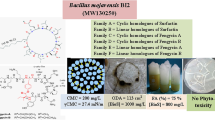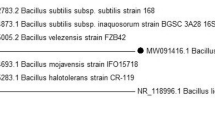Abstract
A marine Bacillus strain produced biosurfactant during its growth in a defined glucose-containing medium. An efficient method for separation and purification of biosurfactant isoforms was developed and optimized in high-performance liquid chromatography (HPLC) by manipulating solvent gradient program and flow rates. Starting with an initial run time of 60 min, the final optimized method had a significantly reduced run time of 20 min. By using this method, all the surface-active isoforms (fractions A–D) were eluted within 12 min of elution with much shortened retention time of each component. The purity levels of the isoforms were enhanced using the optimized method as evident from their lower CMC values. Among the four surface-active fractions, antimicrobial action was solely displayed by HPLC fraction A. FTIR analysis revealed all the HPLC fractions to be lipopeptide in nature and MALDI-ToF mass spectral analysis showed that these belonged to the fengycin family containing C15, C16, and C17 fengycins.






Similar content being viewed by others
References
Mukherjee S, Das P, Sen R (2006) Towards commercial production of microbial surfactants. Trends Biotechnol 24:509–515
Das P, Mukherjee S, Sen R (2008) Genetic regulation of the biosynthesis of microbial surfactant: an overview. Biotechnol Genet Eng Rev 25:165–186
Rodrigues L, Banat IM, Teixeria J, Oliveira R (2006) Biosurfactant: potential application in medicine. J Antimicrob Chemother 57:609–618
Desai JD, Banat IM (1997) Microbial production of surfactants and their commercial potential. Microbiol Mol Biol Rev 61:47–64
Das P, Mukherjee S, Sen R (2008) Antimicrobial potential of a lipopeptide biosurfactant derived from a marine Bacillus circulans. J Appl Microbiol 104:1675–1684
Cameotra SS, Makkar RS (2004) Recent applications of biosurfactant as biological and immunological molecules. Curr Opin Microbiol 7:262–266
Maneerat S, Phetrong K (2007) Isolation of biosurfactant-producing marine bacteria and characteristics of selected biosurfactant. Songklanakarin J Sci Technol 29:781–791
Vater J, Kablitz WC, Franke P, Mehta N, Cameotra SS (2002) Matrix-assisted laser desorption ionization- time of flight mass spectrometry of lipopeptide biosurfactant in whole cells and culture filtrates of Bacillus subtilis C-1 isolated from petroleum sludge. Appl Environ Microbiol 68:6210–6219
Romera D, Ad V, Rakotoaly RH, Dufour SE, Veening JW, Arrebola E, Cazorla FM, Kuipers OP, Paquot M, Garcia AP (2007) The iturin and fengycin family of lipopeptide are key factor in antagonism of Bacillus subtilis towards Podosphaera fusca. Mol Plant Microbe Interact 20:430–440
Sun L, Lu Z, Bie X, Lu F, Yang S (2006) Isolation and characterization of a co-producer of fengycins and surfactins, endophytic Bacillus amyloliquefaceins ES-2, from Scutellaria baicalensis georgi. World J Microbiol Biotechnol 22:1259–1266
Deleu M, Paquot M, Nylander T (2008) Effect of fengycin, a lipopeptide produced by Bacillus subtilis, on model biomembranes. Biophys J 94:2667–2679
Mukherjee S, Das P, Sivapathasekaran C, Sen R (2009) Antimicrobial biosurfactant from marine Bacillus circulans: extracellular synthesis and purification. Lett Appl Microbiol 48:281–288
Sen R, Swaminathan T (2005) Characterization of concentration and purification parameters and operating conditions for the small-scale recovery of surfactin. Process Biochem 40:2953–2958
Lin SC, Chen YC, Lin YM (1998) General approach for the development of high-performance liquid chromatography methods for biosurfactant analysis and purification. J Chromatogr A 825:149–159
Thaniyavarn J, Roongsawang N, Kameyama T, Haruki M, Imanaka T, Morikawa M, Kanaya S (2003) Production and characterization of biosurfactant from Bacillus licheniformis F2.2. Biosci Biotechnol Biochem 67:1239–2003
McInerney MJ, Javaheri M, Nagle DP Jr (1990) Properties of biosurfactant produced by Bacillus licheniformis strain JF-2. J Ind Microbiol 5:95–102
Das K, Mukherjee AK (2005) Correlation between diverse cyclic lipopeptides production and regulation of growth and substrate utilization by B.subtilis strains in a particular habitat. FEMS Microbiol Ecol 54:479–489
Pueyo MT Jr, CB RAMC, Pd M (2009) Lipopeptides produced by a soil Bacillus megaterium strain. Microb Ecol 57:367–378
Leenders F, Stein TH, Kablitz B, Franke P, Vater J (1999) Rapid typing of Bacillus subtilis strains by their secondary metabolites using matrix-assisted laser desorption/ionization mass spectrometry of intact of cells. Rapid Commun Mass Spec 13:943–949
Pabel CT, Vater J, Wilde C, Franke P, Hofemeister J, Adler B, Bringmann G, Hacker J, Hentschel (2003) Antimicrobial activities and matrix-assisted laser desorption/ionization mass spectrometry of Bacillus isolates from the marine sponge aplysina aerophoba. Marine Biotechnol 5:424–434
Fernandes PAV, Arruda IRD, Santos A, AAd A, Maior AMS, Ximenes EA (2007) Antimicrobial activity of surfactants produced by Bacillus subtilis R14 against multidrug resistant bacteria. Braz J Microbiol 38:704–709
Kim PI, Bai I, Bai D, Chae H, Chung S, Kim Y, Park R, Chi YT (2004) Purification and characterization of a lipopeptide produced by Bacillus thuringiensis CMB26. J Appl Microbiol 97:942–949
Acknowledgments
RS and CS acknowledge the Department of Biotechnology (DBT), the Government of India for the project grant (BT/PR-6827/AAQ/03/263/2005) in marine biotechnology. SM acknowledges CSIR, New Delhi for the Senior Research Fellowship. RS acknowledges Department of Biotechnology, IIT Kharagpur. Authors acknowledge Palashpriya Das for taking pains in strain isolation and for her all-round support throughout this work.
Author information
Authors and Affiliations
Corresponding author
Rights and permissions
About this article
Cite this article
Sivapathasekaran, C., Mukherjee, S., Samanta, R. et al. High-performance liquid chromatography purification of biosurfactant isoforms produced by a marine bacterium. Anal Bioanal Chem 395, 845–854 (2009). https://doi.org/10.1007/s00216-009-3023-2
Received:
Revised:
Accepted:
Published:
Issue Date:
DOI: https://doi.org/10.1007/s00216-009-3023-2




